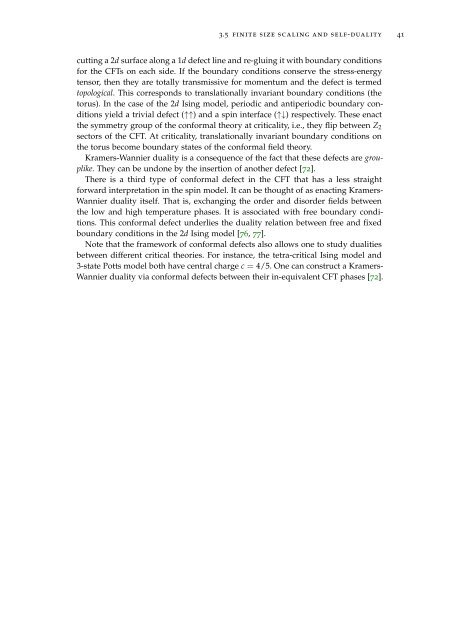Topology, symmetry, and phase transitions in lattice gauge ... - tuprints
Topology, symmetry, and phase transitions in lattice gauge ... - tuprints
Topology, symmetry, and phase transitions in lattice gauge ... - tuprints
You also want an ePaper? Increase the reach of your titles
YUMPU automatically turns print PDFs into web optimized ePapers that Google loves.
3.5 f<strong>in</strong>ite size scal<strong>in</strong>g <strong>and</strong> self-duality 41<br />
cutt<strong>in</strong>g a 2d surface along a 1d defect l<strong>in</strong>e <strong>and</strong> re-glu<strong>in</strong>g it with boundary conditions<br />
for the CFTs on each side. If the boundary conditions conserve the stress-energy<br />
tensor, then they are totally transmissive for momentum <strong>and</strong> the defect is termed<br />
topological. This corresponds to translationally <strong>in</strong>variant boundary conditions (the<br />
torus). In the case of the 2d Is<strong>in</strong>g model, periodic <strong>and</strong> antiperiodic boundary conditions<br />
yield a trivial defect (↑↑) <strong>and</strong> a sp<strong>in</strong> <strong>in</strong>terface (↑↓) respectively. These enact<br />
the <strong>symmetry</strong> group of the conformal theory at criticality, i.e., they flip between Z 2<br />
sectors of the CFT. At criticality, translationally <strong>in</strong>variant boundary conditions on<br />
the torus become boundary states of the conformal field theory.<br />
Kramers-Wannier duality is a consequence of the fact that these defects are grouplike.<br />
They can be undone by the <strong>in</strong>sertion of another defect [72].<br />
There is a third type of conformal defect <strong>in</strong> the CFT that has a less straight<br />
forward <strong>in</strong>terpretation <strong>in</strong> the sp<strong>in</strong> model. It can be thought of as enact<strong>in</strong>g Kramers-<br />
Wannier duality itself. That is, exchang<strong>in</strong>g the order <strong>and</strong> disorder fields between<br />
the low <strong>and</strong> high temperature <strong>phase</strong>s. It is associated with free boundary conditions.<br />
This conformal defect underlies the duality relation between free <strong>and</strong> fixed<br />
boundary conditions <strong>in</strong> the 2d Is<strong>in</strong>g model [76, 77].<br />
Note that the framework of conformal defects also allows one to study dualities<br />
between different critical theories. For <strong>in</strong>stance, the tetra-critical Is<strong>in</strong>g model <strong>and</strong><br />
3-state Potts model both have central charge c = 4/5. One can construct a Kramers-<br />
Wannier duality via conformal defects between their <strong>in</strong>-equivalent CFT <strong>phase</strong>s [72].
















